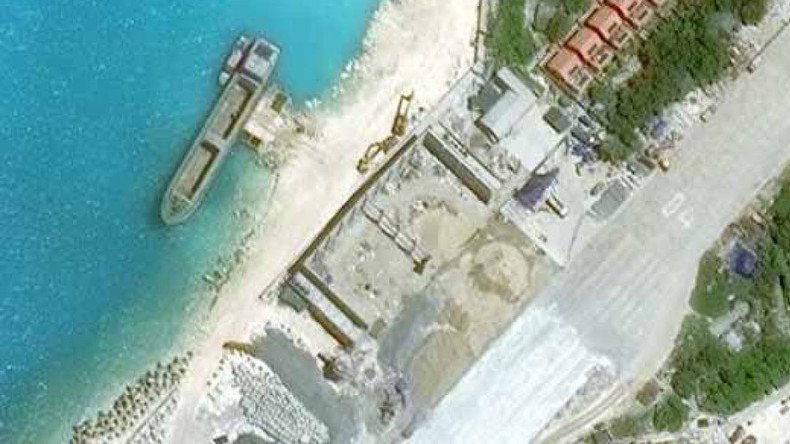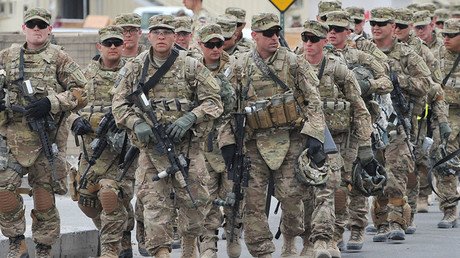Vietnam extending S. China Sea runway in defiance of Chinese land claims – US think tank

Vietnam is lengthening a runway and building large hangars on a disputed South China Sea island in defiance of Chinese efforts to build military facilities on artificial islands in the troubled region, a US-based think tank said in a report.
The Vietnamese are lengthening the runway on Spratly Island from less than 760 meters to about 1,000 meters, Washington-based Asia Maritime Transparency Initiative (AMTI) said in a new report on Thursday.
The island is one of 14 that, along with more than 100 reefs, make up the Spratly chain, which is claimed by China, Vietnam, Taiwan, and the Philippines.
Satellite images cited by the AMTI also show that Vietnam is building two large hangars on the island capable of housing all types of combat aircraft, including fighter jets, the Vietnamese Air Force’s PZL M28B maritime surveillance aircraft, and CASA C-295 transport planes, though limited space on the tarmac would impose significant constraints on flight operations.
Vietnam Responds with Spratly Air Upgrades https://t.co/emIY8azctm develop of Spratly Island, including runway extension pic.twitter.com/Ide68PryO6
— M. Taylor Fravel (@fravel) 17 ноября 2016 г.
The move comes as an apparent attempt to boost Vietnam’s military presence in the disputed area. Earlier in August, Reuters reported that the southeast Asian country had deployed state-of-the-art mobile rocket launchers at its five bases in the South China Sea that are believed to be capable of hitting Chinese installations.
Hanoi dismissed the report as “inaccurate” without elaborating, but experts say the alleged deployment would be Vietnam’s most significant military effort so far.
“When Vietnam acquired the system, it was always thought that it would be deployed on the Spratlys ... it is the perfect weapon for that,” Siemon Wezeman, a senior arms researcher at the Stockholm International Peace Research Institute (SIPRI), told Reuters in August.
The extension of the runway and Vietnam’s other military activities coincide with efforts China has been making to boost its own presence on the Spratly reefs since 2013.
The Chinese runways, which are capable of landing fighter jets, created huge concern in the US, as China’s growing ability to project its power in the western Pacific is putting a severe strain on Washington’s so-called ‘pivot to Asia’. US officials have consistently accused China of endangering ‘maritime security,’ but Beijing maintains it has legitimate claims over the region.
However, some experts believe the US is not in a position to meddle in the South China Sea dispute, despite its stated goal of safeguarding the freedom of navigation.
As long as Washington has not ratified the United Nations Convention on the Law of the Sea (UNCLOS), “it is not appropriate for the United States to meddle or, even worse, demonstrate military might there,” Connie Rahakundini, president of the Indonesian Institute for Maritime Studies (IIMS), told Xinhua in June.
There are other signs indicating that the South China Sea dispute has more to do with Washington’s military posture in the region, as well as its fears of Chinese capabilities of protecting its interests in contested waters. The US also considers China a primary security threat in Asia, and continues to deploy naval assets to the region.
Previously, the US began air and sea “patrols” in the disputed waters, sending guided-missile destroyers and reconnaissance aircraft to monitor the area. Beijing, in turn, accused Washington of intentionally sending US warships to Chinese territorial waters “without permission,” responding to the incursions with surprise naval drills.
Given that the three Chinese bases have already become operational, the gap between Hanoi’s and Beijing’s military capabilities will only grow, but Vietnam is determined to monitor and defend its claims in the region, said Gregory Poling, the AMTI director.
“Vietnam is likely to make use of its improved runway and hangars at Spratly Island to bolster its ability to patrol the Spratlys,” he noted. In light of the mounting tensions in the region, it is not surprising that Vietnam is speeding up the modernization of its military by purchasing cutting-edge weapons systems from abroad.
Beijing goes mobile in the South China Sea
In February, Russian Admiralty Shipyard delivered a Kilo-class diesel-electric submarine to the Vietnamese Navy as part of $2 billion Russia-Vietnam deal to supply six vessels by the end of 2016. The first of these subs, which are considered to be one of the quietest powered by diesel in the world, have already begun patrolling the South China Sea, according to Vietnamese officials.
Vietnam’s military is also interested in acquiring patrol helicopters and aircraft, as well as fast attack boats that can operate in coastal waters, according to open sources.
Notably, in late May, the US completely lifted the ban on selling lethal weapons to Vietnam, which President Tran Dai Quang described as “a clear proof that both countries have completely normalized relations.”













